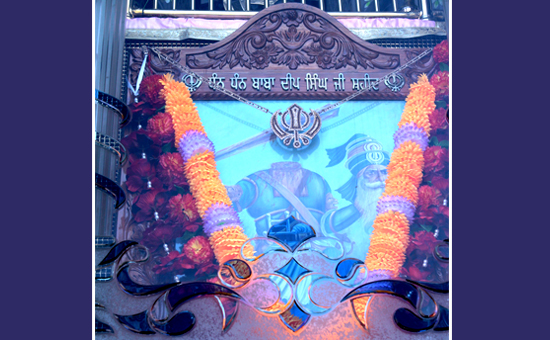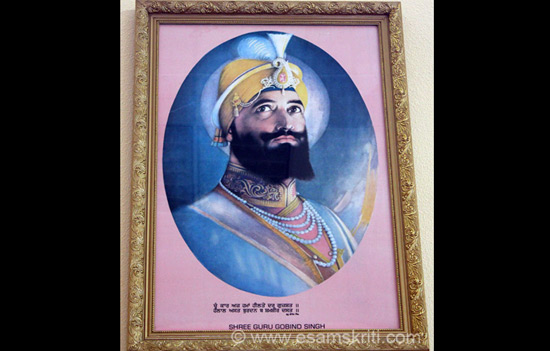- Know how Shivaji inspired Punjab and Veer Savarkar inspired Bhagat Singh, when Marathas/Sikhs drove out Afghans and desecration of Hari Mandir during Abdali’s invasions.
- Post the Battle of Panipat the
weakened Afghans could no longer hold Punjab and soon a powerful Sikh state
emerged.
Many articles are triggered by comments
or questions of others. A Sikh (origin from Sanskrit word Shishya) from Amritsar, on social media, expressed gratitude to the Marathas. It got me wondering why!
A historian friend, who specialises in Maratha history, told me of interactions around 1758-59. I also referred to the Holy Gita of books on Indian History and Culture published by the Bharatiya Vidya Bhavan amongst others including Sikh sites.
This article tells how Shivaji inspired Punjab, Abdali’s Punjab invasions, how Marathas/Sikhs drove out the Afghans and Veer Savarkar inspired Bhagat Singh.
 Shivaji Maharaj, Tawang, Arunachal P.
Shivaji Maharaj, Tawang, Arunachal P.
Shivaji Maharaj’s Agra escape inspired India including Punjab
Just to get a sense of dates – Chhatrapati Shivaji lived from 1627 to 1680. Tegh Bahadur was Guru from 1664-1675 and the 10th Guru, Govind Singhji (GGS) was Guru from 1675
to 1708.
Shivaji Maharaj was in Agra jail from 12 May to 18 August 1666. His dramatic escape made him an all India-figure. His reputation peaked for having outwitted Aurangzeb, considered the cleverest and mightiest of emperors then. Jadunath Sarkar wrote (excerpts), “He taught modern Hindus to rise to the full stature of their growth. Shivaji has shown that the tree of Hinduism is not really dead, that it can rise from beneath the seemingly crushing load of centuries of political bondage.” 1 Pg. 278
GGS “wanted to create a national awakening in Punjab as was done in Maharashtra by Shivaji.” 1 Pg. 316 GGS founded Khalsa on 30/3/1699, a good nineteen years
after Shivaji passed away.
After relentlessly fighting the Mughals
for years, GGS moved to Nanded, Maharashtra
in August 1707. He moved to the headquarters of
Lachman Das or Madho Das Bairagi, (who accepted to be a disciple of GGS
hence renamed Banda Bahadur).
Meanwhile Vazir Khan of Sirhind was plotting against the Guru’s life. At Nanded he was stabbed by two Pathan boys in August 1708. Following the practice of Hindu saints, who at the divine call would set in a samadhi and expire, the Guru had prepared a funeral pyre for himself. He was yet to complete 42 years
when GGS calmly walked into it on 7/10/1708. Before GGS’s death he sent Banda back to Punjab to continue the war against the Mughals as Commander-in-Chief of Khalsa forces (Ref: Life of Banda Bahadur by Ganda Singh Page-24) while the Guru’s wife, Mata Sahib Devi, returned to Delhi. Banda died in 1716.
Khushwant Singh wrote, “Although Banda’s success was short lived, it proved that the peasants were disconnected and administration feeble. In seven stormy years Banda changed the class structure of land holdings in the southern half of the state by liquidating many of the big Muslim zamindars of Malwa and Jullundur Doab. Large estates were first broken into smaller holdings in the hands of Sikh or Hindu peasants. With the rise of Sikh power, these holdings were once again grouped together to form large estates, but in the hands of Sikh chieftains.” 5 pg. 113
Ahmed Shah Abdali
When Abdali invaded India for the fourth
time in 1756, he left his son Timur Shah for administration of Punjab, Kashmir
etc with Afghan General Jahan Khan as his vazir. Both wanted to subjugate the
Sikhs.
Deep Singh fought valiantly but Amritsar
was occupied and the Harimandir desecrated. 2 Pg. 131 and 3 Pg. 140 You can read more about Deep Singhji's story Here (pic number 18)
 Deep Singh, hero of 1756 battle with Afghan General Jahan Khan. Pranams.
Deep Singh, hero of 1756 battle with Afghan General Jahan Khan. Pranams.
A Maratha newsletter records that at the end of March 1757 when the front division of Abdali’s army was transporting the plundered wealth from Delhi to Lahore Ala Singh and others robbed half of half of the treasure. Sikh bands even slew Abdali’s guards. So upset was Abdali when he arrived at Lahore, that he ordered the Harimandir
to be blown up and the sacred pool filled with entrails of slaughtered
cows, just because he could not lay his hands on the Sikhs who troubled him. 3 Pg. 139
Raghunath Rao marched to Delhi with a strong Maratha army and proceeded to Punjab in April 1758. He defeated Abdali’s governor and expelled the Afghans. 2
Pg. 125 According to Khushwant Singh, a few Sikh misls helped the Marathas take
Sirhind. 3 Historian Dr Uday S Kulkarni also wrote that, “many Sikh misls–to who Abdali was the common enemy, joined
Raghunathrao and Malharji Holkar and the armies entered Punjab.”
As the Sikh and Maratha armies crossed
the Sutlej, Jahan Khan retired to Lahore. A few days later the entire Afghan
army vacated the city.
Raghunath Rao entered Lahore in April 1758. While Adina Beg Khan (Mughal Governor of Punjab) feted him the Sikh and Maratha cavalry pursued the Afghan prince Taimur and general Jahan Khan who barely escaped. However, their camp and heavy baggage were captured and brought to Lahore. 3
Most of the
Afghan troops were killed in the Battle of Chenab River by the joint
Maratha-Sikh forces. The leading Sikh nobles in this force were Charat Singh
Shukarchakia (grandfather of Maharaja Ranjit Singh), Jassa Singh Ahluwalia and
Jassa Singh Ramgarhia. The Afghan prisoners-of-war found after the Battle of
Chenab River were taken back in heavy chains to Amritsar where they were forced
to clean the sacred site of Harimandir which was earlier demolished and
desecrated by Abdali and Jahan Khan.
On their arrival at Amritsar, Marathas paid a visit to Harimandir and in return were felicitated by the Sikh chiefs. (Ahmad Shah Durrani- By Ganda Singh- Page 205-206)
By 1758 Attock (98 kms away from Peshawar) was captured and crossing the Indus, Maratha
armies under Tukoji Holkar and Sabaji Scindia reached Peshawar from where the
last vestiges of the Afghans were evicted. I am not 100% sure but believe it
was a Maratha-Sikh-Mughal effort.
The threat was
too great for Abdali to ignore for long and by July 1759 his fifth invasion of
India started. However, when General Jahan Khan entered Punjab,
the joint forces of the Marathas and Sikhs defeated the Afghans.
Read How the Marathas
captured Attock in modern day Pakistan
Aside, note that according to this Speaking Tree article “In 980 C.E. Afghanistan was also a place where the people were Hindus and Buddhists. The name "Afghanistan" comes from "Upa-Gana-stan" which means in Sanskrit "the place inhabited by allied tribes.” The region was home to many Shiva temples and Buddhist shrines.
Inspite of the wealth repeatedly looted from
India why is Afghanistan in this state today?
Battle of Panipat
Khushwant Singh wrote, “It could be said that the battle of Panipat that was fought between the Marathas and Afghans was really won by the Sikhs.” 3 Pg. 145 This
is echoed by Col Anil Athale (retd) who wrote in Rediff.com “The weakened Afghans could no longer hold Punjab and soon a powerful Sikh state came up and ruled from Lahore.”
Khushwant Singh wrote that post the third battle of Panipat, “Sikhs liberated over 2,000 Hindu women Ahmad Shah Abdali was taking to stock the Afghan harems.” 5 Pg. 145 In the Rediff article Col Athale wrote, “In the battle of Govindwal, the Sikhs rescued many Maratha prisoners who were being carried off to Afghanistan as slaves. Many widows never came back and instead married Sikh soldiers. Many Marathas, instead of coming back to Maharashtra, went to the hills in the north and settled there.” Hills could be Kumaon because many Joshi's and Pants live there today.
Abdali raided India for the seventh time
in March 1764. He had to retreat from Lahore and returned for the last time in
1767. But he could not suppress the Sikhs. For the third time, Afghans blew up
the Harimandir and filled the pool with dead cows. 5 Pg. 152
 Guru Govind Singhji in San Jose Gurudwara, California, U.S.A.
Guru Govind Singhji in San Jose Gurudwara, California, U.S.A.
Veer Savarkar and Sikhs
Dhananjay Keer wrote in Veer Savarkar, “He learnt Gurumukhi script and read all the
religious and important original writings and issued many pamphlets. His
pamphlet named Khalsa and many others
issued in Gurumukhi rained into the hands of Sikh soldiers, making them conscious of their duty and of the coming storm.” 4 Pg. 35
Savarkar’s book The Indian War of Independence of 1857 inspired many. Bhagat Singh
of Punjab printed 2,000 copies of that famous book to raise funds for his
revolutionary society. 4 Pg. 217
“Echoes of this great work were visible in 1914. It inspired the second war of Indian Independence in 1914. Leaders of the Ghadr party who published the book and spread its message, raised the Komagatamaru Rebellion. Bhagat Singh and his colleagues brought out an underground edition in 1928 to feed the flames of revolution and finance their Party. They regarded the great work as the Geeta of revolutionaries.” 4 Pg. 69
British divided society in
Punjab and perhaps Maharashtra
The British realized the importance of Marathas and Sikhs (both nationalist) in defeating the Afghans so they sought to weaken their society to strengthen themselves.
Thus, the British divided Punjab into Hindu and Sikh and accentuated caste differences by making caste the basis of land ownership. (Briefly, from the 1860’s to 1930 the British created the Hindu-Sikh divide by stating that only those sporting five K's could join the army, supporting the Tat Khalsa Movement, passing the Land Alienation Act in 1900 and the Sikh Gurudwara Act in 1925.)
Read How the British
divided Punjab into Hindu and Sikh
I am yet to do a similar study for
Maharashtra but wish to leave you with some thoughts.
“K. N. Behere in his work ‘Background of Maratha Renaissance in the
Seventeenth Century: A Historical Survey of the Social Relations and Political
Movements of the Marathas’5 gives a detailed account of Vaishnavism in Maharashtra and elaborates on Mahanubhava sect and Varkari sect. He also analyses historical contribution of the saints of the Varkari tradition as well as that of Ramdasa. He argued that the works of
these sects and saints provided the background for the Maratha renaissance, which he believed was in the form of establishment of Swaraj under Shivaji.” Sambhus Varada. The Debate Over Bhagwat Dharma and Maharashtra Dharma. M/Phil Dissertation. New Delhi: Jawaharlal Nehru University, 2012.
To add to the above, author Aneesh Gokhale wrote
in Swarajyamag, “Particularly in Maharashtra, the Bhakti movement ran parallel to the eclipse of the Hindu power and the rise of the Deccan sultanates. This was the most trying time for the people, who, having lost the state patronage of their religion, now turned to simple bhakti as propounded by the likes of Sant Dyaneshwar, Eknath, Namdev, Tukaram and others.”
Thereafter, caste differences in Maharashtra were accentuated that are seen to this day. Society is now divided into Brahmins, Marathas, Backward Classes, Scheduled Castes and Tribes instead of Marathas.
A well-researched piece (inputs welcome) on how British divided Maharashtra on caste lines would require a separate essay. Suffice to say that Dr Ambedkar (a depressed class leader) became a national figure during British rule unlike any other depressed classes leader countrywide. THINK. I admire some of Dr Ambedkar’s writings, am his fan.
References
1. History and Culture of Indian People
Volume 7 by Bharatiya Vidya Bhavan.
2. History and Culture of Indian People
Volume 8 by Bharatiya Vidya Bhavan.
3. History of Sikhs Volume 2 by
Khushwant Singh.
4. Veer Savarkar by Dhananjay Keer.
5. History of Sikhs Volume 1 by
Khushwant Singh.
Also
read
1. How Shivaji Maharaj inspired India’s freedom struggle
2. Misconceptions
surrounding the Battle of Panipat
3. When Marathas had
a face-off with Sikhs in Punjab